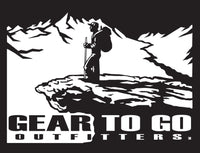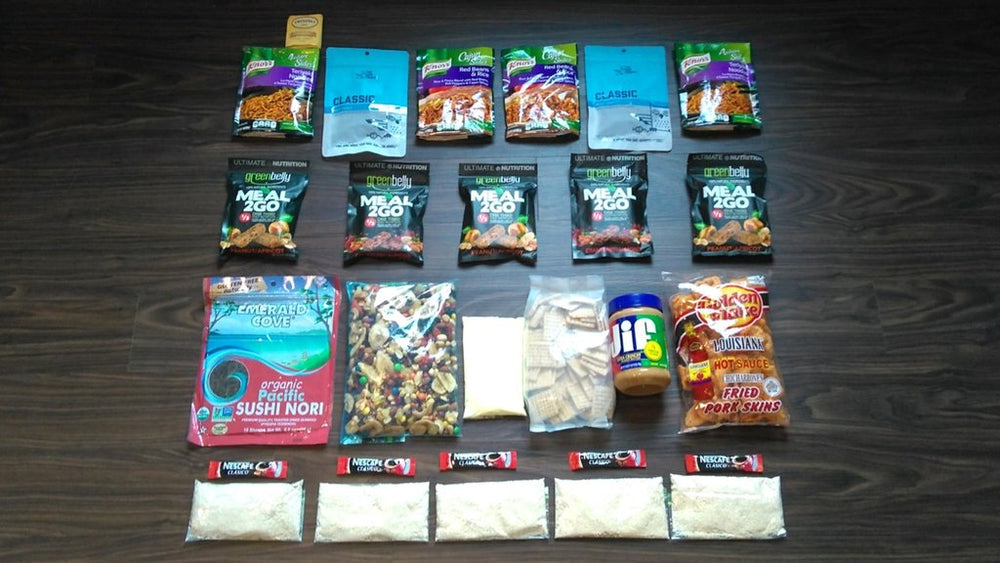We don't have any recipes for a 4-course backcountry meal, but we do have some wide-ranging tips on planning and preparing food while camping or backpacking. Next to water and a good pair of shoes, food is certainly important "gear" - something has to fuel the several thousand calories a day you can burn thru while hiking. So scan our menu of suggestions below, and bon appetit!
- When deciding what to carry as nourishment, consider the bang for the pound - carry those food items that deliver the most calories for the weight or bulk you have to pack. See more about loading backpacks here. You don't want to go hungry, but there's no point in overloading your pack either. Review the content labels and figure the total calories in a container of food and then compare to the weight of the contents. Lots of high-water content foods like fruits or prepared soups aren't good bets for backpacking, for example. (Fruit to eat the first day isn't a bad load though). Fatty foods that travel well (not all do) often have double the calories per ounce of carbohydrates. Also consider the weight of the container itself, which pretty much rules out canned goods. Look for freeze-dried or powdered foods you can mix with water found near your campsites for minimal weight. But if you're car-camping, anything goes, since carrying weight or bulk isn't a factor.
- 1 - 2 pounds per day is usually enough food to meet your caloric needs. Unless you're a really big guy, you can make it on the lower side of that on weekend trips since you always know you can pig out at a restaurant as soon as you get out of the woods. On longer trips any accumulating calorie deficit will have a more negative effect on your hiking ability, so plan on eating more per day to ingest close to what you're burning. Also, in colder weather, you'll burn a lot of calories just to stay warm, so pack accordingly.
- Instead of carrying food in its original container, carry serving-sized amounts in sealable baggies. This cuts down on weight and trash, and the bags can have many other uses during your trip.
- You can take some fresh fruit and veggies despite the weight - just make sure to eat those first to get rid of the weight as soon as possible and to eat before they spoil.
- Pack just enough food to get you thru your planned trip, plus an extra cold meal or two just in case you run into a delay in getting out, or run out of fuel.
- Unless you carry only pre-cooked items, carry a backpacking stove to cook your meals. Don't rely on fires, which are tricky to cook over and increasingly restricted anyway. Cover your cooking pot when heating to save fuel.
- Love condiments but don't want to pack a refrigerator? Not that we would condone such a thing, but the reality is, the best source for those little packs is to snag them from your favorite fast food restaurant or convenience store. That way you can bring mayo, mustard, relish, hot sauce, etc with no refrigeration required!
- Adherents to an Atkins-style diet can fall off the wagon a bit on a backpack trip without too much concern - you may need at least some carbs during the day for energy unless you're fully keto-adapted. A limited amount of sugar-carbs are OK since you'll be burning off the calories as you go, but better still are complex carbs for longer, controlled calorie absorption. Note that some energy bars are no better than candy bars as far as minimizing blood sugar spikes. Protein during the day won't absorb as well to give off the energy you may need; save your protein-heavier foods for dinner after you're in camp. There's nothing wrong with protein-friendly tuna fish or peanut butter during the day; just be sure to supplement with a few carbs if you'll be working hard. Drink lots of water when you eat to aid digestion. Learn more about water usage while hiking.
- Beware of too much chocolate in energy bars or snacks; not because of the calories - it's the melting that's the pain. M&M's and hot chocolate mix are good bets if you want chocolate without a melting mess.
- Avoid overeating in general during the day; eat just enough to keep your energy levels up, but not so much to get bogged down from trying to hike hard on a full stomach.
- Adding various spices to otherwise bland food is a big help; just don't overdo it and get your stomach all in knots. Some good suggestions - garlic cloves, onion, spiced oil, hot mustard, and dried salsa. Stash in clean prescription bottles or other small plastic container.
- Avoid meals that are messy or time-consuming to prepare. Don't mix your food in the same pot you use to boil water unless it's desinged to be more of a non-stick pot (they all stick some). Instead, take an additional easily cleaned container for mixing and re-hydrating dried foods. Use this container to hold food and condiments when stowed in your pack.
- To keep hungry animals away, store food away and pick up spills. Never sleep with food (or other aromatic items like toothpaste, gum, etc.) in your tent -- hang it in a bag from a high tree limb, or store in a bear canister. See more information on bear precautions.
- Check out the cooking times for anything you bring. Some packaged products require more than 20 minutes; stick to preparation times of 10 minutes or less to cut down on fuel usage and hassle.
Freeze-dried food designed for backpacking trips is available in endless varieties, including desserts. Some of it is better than others; we stick to dried noodles and tomato-sauce selections which are apparently harder to screw up - we carry a few meal dehydrated options, and most outdoor stores have a selection.
However, since some dehydrated meals are a bit expensive, you can can consider making your own with an inexpensive dehydrator or shop the regular grocery store and find good substitutes. Here's some grocery suggestions:
- Oatmeal is a classic king of the trail - it's generally OK for anyone not carb-averse, easy to prepare, and lightweight. For best results, put individual servings into baggies. Add desired amount of sugar, cinnamon etc to each bag. Same goes for instant hot cereals, mashed potatoes, rice and other inexpensive dehydrated foods like couscous, instant grits, Chinese noodles, hash browns, refried beans, and chili. Visit your local food co-op or health store and browse in their bulk section for a good selection - you can buy as much or as little as you want.
- Make your own trail mix (aka GORP- Good Old Raisins and Peanuts) with M&M's, mixed nuts and raisins. Separate into a daily allotment in baggies so you don't overeat on it during any single day. It's great stuff, but real boring by day 3 or 4. So mix it up with some pretzels, other nuts, crackers, sesame sticks, malt balls, dried fruit, cheese, etc for longer trips.
- For a warming breakfast, take along a few flow-through coffee and tea bags, instant coffee packets, spiced cider packs or hot chocolate.
- You have lots of powdered soup options to choose from - dump the containers and repackage in baggies.
- Look for tuna fish in foil pouches. The packets cost more, but weigh less than a can. Note there is usually a lot of water weight in the pouches, so don't carry more than 1 or 2.Bread is OK for a few days, but prone to crushing. Try tortillas instead.
- Peanut butter is great on backpacking trips - take it out of the jar and put in a baggie. Cut one corner off so you can squeeze it onto your bread without using a knife, then store that cut bag into another baggie.
- Some hard sausages and cheeses will keep for several days on the trail; keep well-sealed in your pack and eat first.


Comments
0 comments